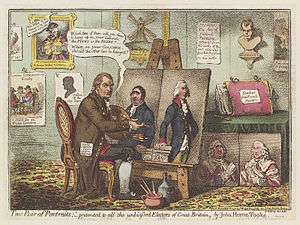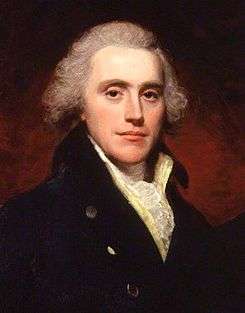First Parliament of the United Kingdom
| | |||||||||||||||||||||||||||||||||||
| |||||||||||||||||||||||||||||||||||
| |||||||||||||||||||||||||||||||||||
| |||||||||||||||||||||||||||||||||||
In the first Parliament to be held after the formation of the United Kingdom of Great Britain and Ireland on 1 January 1801, the first House of Commons of the United Kingdom was composed of all 558 members of the former Parliament of the Kingdom of Great Britain and one hundred of the members of the House of Commons of Ireland.
The Parliament of Great Britain had held its last general election in 1796 and had last met on 5 November 1800. The final general election for the Parliament of Ireland had taken place in 1797, although by-elections had continued to take place until 1800.
The other chamber of the Parliament, the House of Lords, consisted of the members of the pre-existing House of Lords in Great Britain, in addition to 28 representative peers elected by members of what had been the Irish House of Lords.
By a proclamation dated 5 November 1800, the members of the new united Parliament were summoned to a first meeting at Westminster on 22 January 1801. At the outset, the Tories led by Addington enjoyed a majority of 108 in the new House of Commons.
Political situation
Great Britain had been at war with France since 1792. The Prime Minister since 1783, William Pitt the Younger, led a broad wartime coalition of Whig and Tory politicians.
The principal opposition to Pitt was a relatively weak faction of Whigs, led by Charles James Fox. For four years after 1797 opposition attendance at Westminster had been sporadic as Fox pursued a strategy of secession from Parliament. Only a small group, led by George Tierney, had attended frequently to oppose the ministers. As Foord observes "only once did the minority reach seventy-five, and it was often less than ten".

The Act of Union 1800 created the United Kingdom by merging the previous Kingdoms of Great Britain and Ireland. The first Parliament of the United Kingdom was composed of all the members of the last Parliament of Great Britain and some of the members of the final Parliament of Ireland.
Pitt wished to grant Catholic emancipation (the right for Roman Catholics to sit in Parliament), to help reconcile the Irish Catholic majority with the Union. King George III was opposed to that policy, so Pitt was compelled to resign in March 1801.
The new Tory Prime Minister was Henry Addington. He led another wartime administration of pro-government Whigs and Tories. This was however weaker than Pitt's Ministry as Pitt and his faction did not join the new government.
The younger opposition Whigs also became more involved in Parliamentary opposition. Charles Grey, on 25 March 1801 tried to persuade the House of Commons to set up a Committee on the State of the Nation. His motion was lost, but it attracted 105 supporters. The Foxite leaders gradually ended their secession from Parliament.
Pitt was generally supportive of the Addington Ministry, but was semi-detached from it. As the well known couplet tellingly observed "Pitt is to Addington, as London is to Paddington", which indicates the contemporary view of the relative abilities of the two Prime Ministers.
Dates of co-option
All British MPs and those Irish members representing constituencies which retained two members after the Union (the thirty-two Irish counties and the cities of Dublin and Cork) automatically retained their seats when the Union took effect on 1 January 1801.
Those members of the Irish House of Commons to sit at Westminster, who represented constituencies still enfranchised after the Union but reduced from two members to one (the remaining thirty one most considerable Irish boroughs and Dublin University), were selected by drawing lots. If one of the seats in the Irish Parliament was vacant, then the remaining member for the constituency was automatically chosen for the Westminster Parliament. If both seats were vacant a by-election was held.
Summary of the constituencies

Key to categories in the following tables: BC - Borough/Burgh constituencies, CC - County constituencies, UC - University constituencies, Total C - Total constituencies, BMP - Borough/Burgh Members of Parliament, CMP - County Members of Parliament, UMP - University Members of Parliament.
Monmouthshire (1 County constituency with 2 MPs and one single member Borough constituency) is included in Wales in these tables. Sources for this period may include the county in England.
Table 1: Constituencies and MPs, by type and country
| Country | BC | CC | UC | Total C | BMP | CMP | UMP | Total MPs |
|---|---|---|---|---|---|---|---|---|
| England | 202 | 39 | 2 | 243 | 404 | 78 | 4 | 486 |
| Wales | 13 | 13 | 0 | 26 | 13 | 14 | 0 | 27 |
| Scotland | 15 | 30 | 0 | 45 | 15 | 30 | 0 | 45 |
| Ireland | 33 | 32 | 1 | 66 | 35 | 64 | 1 | 100 |
| Total | 263 | 114 | 3 | 380 | 467 | 176 | 5 | 658 |
Table 2: Number of seats per constituency, by type and country
| Country | BCx1 | BCx2 | BCx4 | CCx1 | CCx2 | UCx1 | UCx2 | Total C |
|---|---|---|---|---|---|---|---|---|
| England | 4 | 196 | 2 | 0 | 39 | 0 | 2 | 243 |
| Wales | 13 | 0 | 0 | 12 | 1 | 0 | 0 | 26 |
| Scotland | 15 | 0 | 0 | 30 | 0 | 0 | 0 | 45 |
| Ireland | 31 | 2 | 0 | 0 | 32 | 1 | 0 | 66 |
| Total | 63 | 198 | 2 | 42 | 72 | 1 | 2 | 380 |
See also
References
- British Electoral Facts 1832-1999, compiled and edited by Colin Rallings and Michael Thrasher (Ashgate Publishing Ltd 2000). Source: Dates of Elections - Footnote to Table 5.02
- British Historical Facts 1760-1830, by Chris Cook and John Stevenson (The Macmillan Press 1980). Source: Types of constituencies - Great Britain
- His Majesty's Opposition 1714-1830, by Archibald S. Foord (Oxford University Press 1964)
- Parliamentary Election Results in Ireland 1801-1922, edited by B.M. Walker (Royal Irish Academy 1978). Source: Types of constituencies - Ireland)


